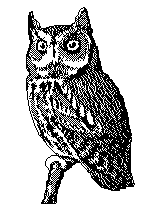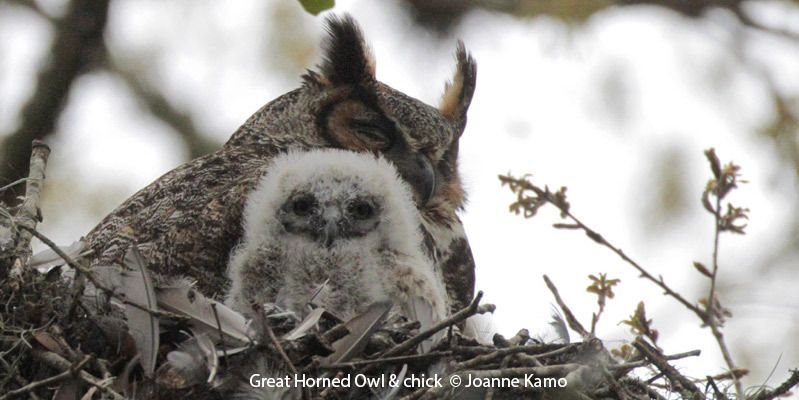
As dusk falls, the backyards of Houston come alive with an astonishing diversity of wildlife ...
Why do they wait to come out at night?
- Some have developed characteristics which are especially suited for dark conditions, such as the large eyes of an owl.
- Some hunt at night because that is when their food sources are most active, such as bats and nightjars.
- Others are not nocturnal by nature, but have learned to be active at night in order to avoid contact with humans. Skunks and armadillos exhibit this type of behavior.
- Still other animals are not primarily nocturnal, but during the hot summer months hunt at night to avoid the heat. Various snakes often change their hunting times based on temperature.
If you dare, go out some evening armed with a flashlight to find some of our night prowlers!
Amphibians
All adult frogs and toads are carnivorous, eating a wide variety of foods but primarily insects.
Treefrogs
Small (about 1" long). Usually found clinging to vegetation, but cricket frogs have adapted to living on the ground.
Green Treefrog: Usually bright green with horizontal white stripe on side of body. Call is a loud, ringing bell-like sound.
Squirrel Treefrog: Variably yellow to green. Can appear similar to green treefrog. Call is more rasping and a bit softer than the green treefrog. In mid-summer often heard in the daytime after rain showers.
Rio Grande Chirping Frog: Tiny frog with translucent dark or light brown skin. Call resembles that of a cricket.
Blanchard's Cricket Frog: Soft, grayish brown with darker blotches. Unlike most frogs its skin appears rough and warty. Call is a series of clicks.
True Frogs
Medium to large (2" - 5")
Leopard Frog: Slender light-brown frog with dark brown blotches. Call is a soft chuckle.
Bronze Frog: Warm bronze in color, stocky frog. Call resembles the plucking of a banjo string. Often heard in the daytime.
Bullfrog: Largest U.S. frog; can attain 8". Call is the loud unmistakable roar of a bull horn. Prefers large bodies of water. Not a good choice for small ponds, it is fond of eating other frogs and small birds.
Toads
Distinguished from frogs by rough warty skin. Hop rather than leap.
Gulf Coast Toad: Very common. Flattened appearance with dark body and lighter blotches. Skin is very rough, with crests.
Narrow-mouthed Toad: Small toad (less than 2") with an egg-shaped body ending in a small head. Very shy and seldom seen. Prefers shady areas with abundant moisture. Call sounds like the soft bleating of a sheep.
Reptiles
Mediterranean Gecko: 4" - 5", stout lizard with pale tan translucent body and darker spots. Tail is marked by alternating light and dark stripes. Often found around houses. Young geckos readily enter houses. The tail breaks off easily and even continues to wriggle for a short while. This is to distract predators. The tail eventually grows back, although it will not be as long.
Snakes: See our resource page on Snakes of Houston.
Birds
Owls
Perch upright. Rest during the day in trees to emerge at night. Wings flap silently. Large eyes allow for excellent night vision.
Screech Owl: The most common owl in Houston. Very small (8" - 9"), it can be either red or gray in color. Relatively tame and curious, it has been known to follow evening strollers out of curiosity. Mainly eats insects, but also likes to hunt for small fish and frogs. Readily accepts an owl house. Best seen in the early evening or pre-dawn hours. Call is long, descending quavering whinny. A second call is a long, low trill.
Great Horned Owl: Large (23") with "ear" tufts, bright yellow eyes. Prey includes animals as large as rabbits, snakes and skunks. Call is low hoo, hoo, hoo.
Barred Owl: Large (21") with dark eyes, no "ear" tufts. Swamps are its most likely habitat in our area. Call is Who cooks for you?
Barn Owl: Large (16") with white heart-shaped face, white wings and breast, copper and gray back. Readily accepts owl houses and has also been known to use brick archways over chimneys, and, of course, barn eaves.
Nightjars
Perch in a horizontal position. Unusually large mouth with whiskers on each side aid in the catching of insects.
Common Nighthawk: A summer resident, it nests on the ground or on top of flat roofs. Best time to see it in the evening as it chases insects. It has long, tapered wings marked with a white vertical stripe and is a little smaller than a mockingbird. It's call is a soft, breezy pzeent.
Chuck-Will's-Widow: Large (12"), russet brown nightjar. Found in our area in the summer. Generally found in the daytime, when it rests motionless on a tree branch in a shady area. Its name is a representation of its call.
Mammals
Virginia Opossum: North America's only marsupial, with 1 to 14 young being carried in the pouch for 2 months. Opossums eat a wide variety of foods including insects, roaches, carrion, fruit and whatever else they can find. It makes a nest of leaves in an abandoned tree hollow, burrow or other crevice.
9-banded Armadillo: Closely related to sloths and anteaters, it is North America's only edentate. Armadillos eat primarily insects and crustaceans. Their scat looks like clay marbles. Young armadillos are pink, with soft skin, resembling piglets. As they grow their skin hardens to form heavy bony plates of armor. Armadillos love to burrow in loose, moist soil, leaving untidy piles of dirt in their wake. Their breeding burrows can be several feet long.
Bats: A form of sonar called echolocation is used to find insects. The most common bats in our area are the big brown and evening bats. In addition to roosting in trees, they also use house eaves and bat houses. Most commonly seen just after sunset and in the pre-dawn hours when they're hunting insects under city lights and over bodies of water. Flight is a choppy zigzag rather than the smooth swooping of birds. See our Nature Fact Sheet on Bats to learn more.
Southern Flying Squirrel: It doesn't really fly, but is an amazingly adept glider. Seldom seen on the ground. Nests in abandoned woodpecker holes or leafy nests. Call is a soft chirp.
Raccoon: The raccoon has made a remarkable adjustment to taking advantage of human settlements. Its nimble claws can easily open loose garbage lids, and it will gladly make its den in an attic, chimney or storm sewer, in addition to the more traditional tree hollows. It eats a wide variety of foods and will take advantage of whatever is available.
Striped Skunk: A member of the weasel family, the skunk is an omnivore and eats anything from fruit to insects, small animals and eggs. Skunks love to dig in the garden for grubs and leave neat, cone-shaped divots behind, unlike the messy holes of armadillos. They prefer to den in the abandoned burrow of another animal, but will use any protected place.
Online Resources
-
Prepared by Mr. Clint the Snake Man
-
Texas Memorial Museum at UT Austin


